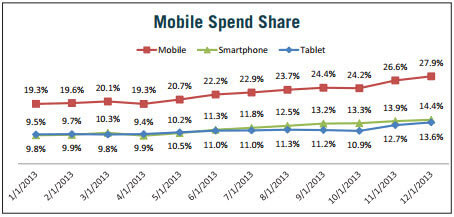How to Profitably Leverage Mobile Paid Search
The growth of the mobile industry is a phenomenon that seemingly knows no bounds. An estimated 57 percent of the U.S. population already owns a smartphone, and spends an average of 2 hours each day socializing, shopping, and surfing on their mobile device.
The time spent in front of a mobile screen represents a tremendous opportunity for savvy local marketers to reach out to a captive audience hungry for information about local products and services. According to the latest research, 80 percent of consumers regularly conduct local searches online, with 1 out of every 4 of those searches being made on a mobile device.
Mobile paid search advertising is likewise enjoying explosive growth, and is expected to account for 50 percent of all Google paid search clicks by the end of 2015. What’s more, consumers are beginning to use their mobile devices to actually complete financial transactions instead of relying on their desktops.
Google’s Enhanced Mobile Paid Search Platform
Google has refined its mobile paid search capabilities to better reach consumers across all types and brands of mobile devices as well as to provide better geo-specific search returns. In addition, Google has streamlined and simplified its mobile paid search campaign management function to allow local marketers to create and optimize effective mobile search campaigns with minimal effort.
- More bidding options. Google already offers time-of-day bid adjustment, which means that you can bid higher for searches made during your normal business hours and less for the hours when your store is closed. Now you can adjust your bid based on location (increase your bid for searches made in close proximity to your store, less for searches originating from outlying areas) and type of device – allowing you to adjust your bid up or down depending on whether the search is being made on a mobile device.
- Smarter ads. Depending on the type of device the user is using to conduct the search, Google will automatically select the appropriate ad format that is best suited for display on that particular device.
- More meaningful conversion tracking. One of the difficulties with tracking the ROI of mobile search campaigns is the fact that the call-to-action frequently requires the visitor to make a phone call – a difficult metric for conventional conversion tracking techniques to measure. Google now offers a mobile search conversion tracker based on the duration of the call, which you can pre-set in advance for each individual campaign.
How to Optimize Your Mobile Paid Search Campaigns
 Mobile paid search advertising calls for a different approach than that found in desktop campaigns. In short, you need to develop a workable mobile strategy tailored to the requirements and opportunities of this unique advertising platform.
Mobile paid search advertising calls for a different approach than that found in desktop campaigns. In short, you need to develop a workable mobile strategy tailored to the requirements and opportunities of this unique advertising platform.
- Set a mobile bid adjustment for your target keywords at the AdWords campaign or ad group level.
- Use mobile-preferred ads to reach your mobile audience. Create a mobile-preferred ad alternative for each of your desktop ads by selecting “Mobile” as your device preference. You can improve the effectiveness of your mobile paid search campaigns by sending mobile visitors to a mobile landing page, keeping your text information short and to-the-point, and announcing your mobile-friendly page to visitors in your display URL.
- Make use of all available ad extensions such as location and call extensions. You’ll improve your click-through rate as well as your quality score, which can help lower your per click costs.










